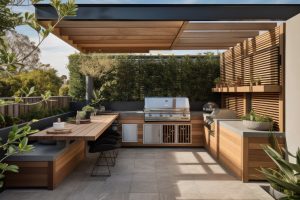Home is more than just a physical space; it’s a place that deeply influences our emotions, well-being, and overall satisfaction. When it comes to home renovation, the changes you make to your living space can have a profound impact on your psychological state. In this exploration, we delve into the psychology of home renovation and how the design and aesthetics of your home can significantly influence your mood.

1. Color Psychology: Painting Your Emotions
Choosing Colors:
The colors you choose for your home’s walls can evoke specific emotions. Warm tones like reds and yellows can create a cozy and energetic atmosphere, while cool tones like blues and greens can induce calmness and relaxation.
Impact on Mood:
- Blues and Greens: These colors are often associated with tranquility and can be ideal for bedrooms or areas where relaxation is key.
- Warm Reds and Yellows: These colors can stimulate conversation and energy, making them suitable for social spaces like the living room.
Tips:
- Consider your desired emotional response for each room and choose colors accordingly.
- Experiment with accent walls or accessories for a subtle yet effective mood boost.
2. Natural Light and Well-being
Maximizing Natural Light:
Increased exposure to natural light has been linked to improved mood, better sleep, and increased productivity. Renovations that focus on maximizing natural light can contribute significantly to your overall well-being.
Impact on Mood:
- Enhanced Mood: Natural light triggers the release of serotonin, the “feel-good” neurotransmitter, promoting a positive mood.
- Better Sleep Quality: Exposure to natural light during the day helps regulate the circadian rhythm, contributing to better sleep at night.
Tip:
- Opt for renovations that allow more natural light into your home, such as larger windows, skylights, or glass doors. Consider light-colored curtains or blinds to maximize light diffusion.
3. Open Spaces and Social Connection
Breaking Down Barriers:
An open floor plan can foster a sense of connection and togetherness. Renovations that eliminate unnecessary walls and barriers between spaces promote social interaction and a feeling of unity among family members.
Impact on Mood:
- Increased Social Interaction: Open spaces encourage communication and shared activities, enhancing family bonds.
- Sense of Freedom: The feeling of spaciousness in open areas can reduce feelings of confinement and stress.
Tip:
- When renovating, consider creating open-concept living areas. Use furniture and decor strategically to define different zones while maintaining a cohesive and connected atmosphere.
4. Personalized Spaces and Emotional Comfort
Creating Personal Sanctuaries:
Individualized and personalized spaces within your home can serve as retreats, providing emotional comfort and a sense of identity. Renovations that allow for personalization contribute to a feeling of belonging.
Impact on Mood:
- Emotional Comfort: Personalized spaces, such as a reading nook or hobby corner, offer comfort and a sense of ownership.
- Reduced Stress: Having a space that reflects your personality can act as a stress reliever and contribute to a positive mental state.
Tip:
Allocate areas for personal expression within your home. This could be a dedicated workspace, a hobby corner, or even a wall for displaying personal memorabilia.
5. Clutter and Mental Well-being
Decluttering Spaces:
A cluttered environment can contribute to feelings of stress and anxiety. Renovations focused on organization and storage solutions play a crucial role in maintaining mental well-being.
Impact on Mood:
- Reduced Stress: A clutter-free space promotes mental clarity and reduces the visual chaos that can contribute to stress.
- Improved Focus: An organized environment allows for better concentration and a more relaxed state of mind.
Tip:
Integrate ample storage solutions during renovations. Consider minimalist design principles to reduce unnecessary clutter and promote a calming atmosphere.
6. Aesthetic Harmony and Visual Pleasure
Creating Aesthetic Appeal:
Aesthetically pleasing surroundings can positively influence mood and overall satisfaction. Renovations that focus on aesthetic harmony contribute to a visually pleasant and emotionally uplifting atmosphere.
Impact on Mood:
- Visual Pleasure: A well-designed and aesthetically pleasing home elicits positive emotions and a sense of satisfaction.
- Stress Reduction: Engaging with beautiful surroundings can lead to lower stress levels and a more relaxed state.
Tip:
- Prioritize design elements that align with your personal aesthetic preferences. Choose decor, colors, and furnishings that bring you joy and create a harmonious visual experience.
Conclusion
Understanding the psychology of home renovation empowers you to make intentional choices that positively impact your mood and well-being. Whether it’s choosing calming colors, maximizing natural light, fostering social connection, or creating personalized spaces, each renovation decision contributes to the overall emotional atmosphere of your home. As you embark on the journey of enhancing your living space, consider the psychological nuances that can turn your home into a sanctuary of positivity and contentment.




